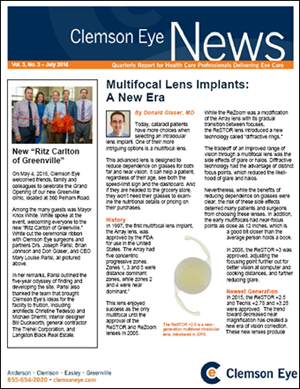Posted by: Clemson Eye in News

By Donald Glaser, MD
Clemson Eye Newsletter, July 2016
Today, cataract patients have more choices when selecting an intraocular lens implant. One of their more intriguing options is a multifocal lens.
This advanced lens is designed to reduce dependence on glasses for both far and near vision. It can help a patient, regardless of their age, see both the speed-limit sign and the dashboard. And if they are headed to the grocery store, they won’t need their glasses to exam-ine the nutritional details or pricing on their purchases.
History
In 1997, the first multifocal lens implant, the Array lens, was approved by the FDA for use in the United States. The Array had five concentric progressive zones. Zones 1, 3 and 5 were distance dominant zones, while zones 2 and 4 were near dominant.1
This lens enjoyed success as the only multifocal until the approval of the ReSTOR and ReZoom lenses in 2005.
While the ReZoom was a modification of the Array lens with its gradual transition between focuses, the ReSTOR lens introduced a new technology called “diffractive rings.”
The tradeoff of an improved range of vision through a multifocal lens was the side effects of glare or halos. Diffractive technology had the advantage of distinct focus points, which reduced the likeli-hood of glare and halos.
Nevertheless, while the benefits of reducing dependence on glasses were clear, the risk of these side effects deterred many patients and surgeons from choosing these lenses. In addition, the early multifocals had near-focus points as close as 12 inches, which is a good bit closer than the average person holds a book.
In 2008, the ReSTOR +3 was approved, adjusting the focusing point further out for better vision at computer and cooking distances, and further reducing glare.
Newest Generation
In 2015, the ReSTOR +2.5 and Tecnis +2.75 and +3.25 were approved. The trend toward decreased near magnification has created a new era of vision correction. These new lenses produce a more continuous range of vision, with the tradeoff being patients may reach for reading glasses a little more often than with the higher magnification, earlier multifocal lens models.
The new lenses use diffractive technology for sharper focuses, and produce fewer side effects than ever. In fact, the newest ReSTOR and Tecnis multifocals had a lower percentage of patients with severe glare and night vision complaints than with these companies’ monofocal (i.e., single focus) lens models. When patients were asked whether they would choose the same multifocal lens again, they answered ‘Yes’ more than 95% of the time.2
There are differences in how much light is dedicated for near vision in the different multifocal lens models. Based on these differences, a surgeon can better customize a solution for patients with different kinds of hobbies and visual needs, and different lenses can even be blended to select the strengths of two different designs.
Alternatives
Monovision, where one eye’s intraocular lens is set for distance vision, and the other for near vision, can be used successfully. However, this is generally only offered to patients who have tried monovision in contact lenses previously and liked the effect.
Accommodative lenses (i.e., Crystalens in the U.S., Synchrony in Europe) can also be used to enhance range of vision. Accommodating lenses work by using the same natural ciliary body muscle that controls our focus in our youth. The lens has flexible hinges that allow the lens to shift forward with a near focus effort. The main downside of an accom-modating lens is that near vision does not generally achieve the same level of detail as with a multifocal lens.
For cataract patients with generally healthy eyes and reasonable expec-tations, multifocal lenses can offer great visual rewards. The eye surgeons at Clemson Eye have been implanting multifocal lenses since 2006. For the thousands of our patients who opted for multifocal lenses, we’ve found they particularly enjoy the lifestyle improve-ments that come with a restored full range of vision and freedom from, or much less dependence, on eyeglasses.
Donald Glaser, MD, is a Clemson Eye ophthalmologist specializing in comprehensive medical and surgical eye care.
1. http://www.aao.org/focalpointssnippetdetail.aspx?id=4152fc11-2a62-485b-8cde-848a4fc1208e.
2. FDA approval studies. Tecnis: www.tecnisiol. com/us/media/pdf/tmf/tecnis-multifocal-low-add-dfu.pdf; ReSTOR: http://ecatalog. alcon.com/IOL_DFU/40-500-231_us_en.
Click here to view and download the July 2016 Clemson Eye Newsletter.